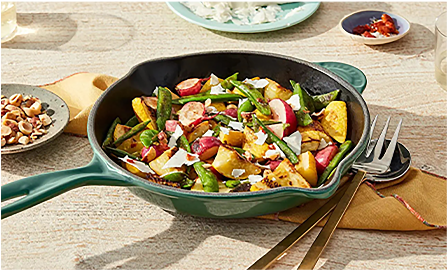
Steps to Season a Cast Iron Frying Pan for Optimal Cooking Performance
The Essential Guide to Seasoning Your Cast Iron Frying Pan
Cast iron frying pans are treasured kitchen tools known for their durability and excellent heat retention. However, to truly unleash the potential of a cast iron skillet, proper seasoning is essential. This process not only creates a non-stick surface but also prevents rust and enhances the flavor of the dishes you prepare. Here’s a step-by-step guide to seasoning your cast iron frying pan.
Understanding the Importance of Seasoning
Seasoning is the process of coating the cast iron with a layer of fat or oil and heating it until the oil polymerizes and forms a protective layer. This layer not only makes the skillet non-stick but also helps to develop a natural patina over time that improves with use. Regular seasoning protects the iron from moisture, which is crucial for preventing rust.
Choosing the Right Oil
When selecting an oil for seasoning, it’s important to choose one with a high smoke point. Common choices include flaxseed oil, grapeseed oil, or vegetable oil. Flaxseed oil is favored by many enthusiasts due to its ability to create a superior hard coating. However, vegetable oil can be a more accessible option for everyday cooks.
The Seasoning Process
1. Start with a Clean Skillet If your cast iron skillet is new, it may already be pre-seasoned. If it’s used, wash it with warm soapy water to remove any old seasoning or debris. This is the only time you should use soap; afterward, stick to hot water and a stiff brush for cleaning.
cast iron frying pan seasoning process

3. Apply Oil Using a paper towel or cloth, apply a thin layer of your chosen oil all over the skillet, including the bottom and handle. Be careful not to apply too much; excess oil can lead to a sticky surface.
4. Heat the Skillet Preheat your oven to around 450°F (230°C). Place the skillet upside down on the middle rack. It’s wise to put a baking sheet on the lower rack to catch any drips. Bake the skillet for about an hour, allowing the oil to polymerize.
5. Cool Down After an hour, turn off the oven and let the skillet cool completely inside. This slow cooling helps to set the seasoned layer.
Maintaining Your Seasoning
Once your skillet is seasoned, maintain it by cooking with oils and avoiding cooking acidic foods, which can strip the seasoning. After use, clean the skillet with hot water and a brush, dry it immediately, and apply a light layer of oil before storing.
Through regular use and care, your cast iron frying pan will develop a rich, seasoned surface that enhances your cooking experience for years to come. Enjoy the process and the mouthwatering meals you can create with your perfectly seasoned cast iron pan!
-
Season Cast Iron Perfectly with GPT-4 Turbo TipsNewsAug.01,2025
-
High Quality Cast Iron Cookware - Baixiang County Zhongda MachineryNewsAug.01,2025
-
Premium Cast Iron Pan: Durable & Perfect HeatNewsAug.01,2025
-
High Quality Kitchen Durable Black Round Cast Iron Cookware Pancake Crepe Pan-Baixiang County Zhongda Machinery Manufacturing Co., Ltd.NewsAug.01,2025
-
Cast Iron Cookware - Baixiang County Zhongda Machinery | Nonstick, Heat ResistanceNewsAug.01,2025
-
High Quality Kitchen Durable Black Round Cast Iron Cookware - Baixiang County Zhongda Machinery | Non-Stick, Heat Retention, DurableNewsJul.31,2025


